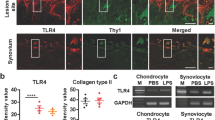Abstract
Objective
To observe the effects of different moxibustion times on proteins of transient receptor potential vanilloid 3 (TRPV3) ion channel protein and synovial cell apoptosis in rats with rheumatoid arthritis (RA), to provide a new basis for the anti-inflammatory mechanism of moxibustion.
Methods
A total of 50 Sprague-Dawley (SD) rats were divided into a normal group, a model group, moxibustion group I, moxibustion group II and moxibustion group III by complete randomization, with 10 rats in each group. Rats in the normal group were bred routinely, and rats in the model group were also bred routinely after successful modeling. After successful modeling, rats in moxibustion group I, II and III accepted consecutive moxibustion at Zusanli (ST 36) and Shenshu (BL 23) for 15 d, once a day, respectively 5 min, 20 min and 30 min for each session. The degree of paw edema was observed and recorded. Immunohistochemical assay was used to detect the protein expression of TRPV3 ion channel in dorsal root ganglia and spinal cord dorsal horn. Terminal-deoxynucleoitidyl transferase-mediated nick end labeling (TUNEL) was used to detect apoptotic synovial cell number.
Results
At the end of treatment, paw circumference of rats in moxibustion group II and III were significantly reduced as compared with that in the model group (P<0.05). TRPV3 ion channel protein expression of dorsal root ganglia and spinal cord dorsal horn was higher in the model group than that in the normal group (P<0.05); the TRPV3 ion channel protein expressions of dorsal root ganglia and spinal cord dorsal horn in moxibustion group II and III were higher than that in moxibustion group I (P<0.05); apoptotic synovial cell number in the model group was larger than that in the normal group (P<0.05), and apoptotic synovial cell numbers in moxibustion group II and III were significantly higher than that in the model group (P<0.05).
Conclusion
Moxibustion of appropriate time could induce TRPV3 expression, and promote synovial cell apoptosis.
摘要
目的
观察不同艾灸时间对类风湿性关节炎(rheumatoid arthritis, RA)大鼠瞬时感受器电位香草酸受体3 (transient receptor potential vanilloid 3, TRPV3)离子通道蛋白及滑膜细胞凋亡的影响, 为艾灸抗炎的作用机制提供新的依据。
方法
将50 只Sprague-Dawley (SD)大鼠按完全随机化分组法分为正常组、模型组、灸 I 组、 灸 II 组和灸 III 组, 每组10 只。正常组常规饲养, 模型组造模成功后进行常规饲养, 灸 I 组、灸 II 组、灸 III 组 造模成功后于足三里、肾俞二穴连续艾灸15 d, 1 次/d, 每次艾灸时间分别为5 min、20 min 和30 min。观察并记录各组大鼠足跖肿胀度, 采用免疫组化法检测背根神经节、脊髓背角TRPV3 离子通道蛋白表达情况, 运用末端脱氧核糖核苷酸转移酶介导的缺口末端标记法(terminal-deoxynucleoitidyl transferase-mediated nick end labeling, TUNEL)检测滑膜组织细胞凋亡数。
结果
治疗结束后, 灸 II 组、灸 III 组大鼠趾围与模型组相比显著减小(P<0.05)。模型组背根神经节、脊髓背角TRPV3 离子通道蛋白表达均大于正常组(P<0.05); 灸 II 组、灸 III 组背根神经节、脊髓背角TRPV3 子通道蛋白表达均大于灸 I 组(P<0.05)。模型组滑膜细胞凋亡数大于正常组(P<0.05), 灸 II 组、灸 III 组滑膜细胞凋亡数显著大于模型组(P<0.05)。
结论
灸治适量时间可引发TRPV3 表达, 利于促进滑膜细胞凋亡。
Similar content being viewed by others
References
Jiang JF, Wang LL, Xu B, Hu L, Song XG, Wu HG. Antiinflammatory: effect mechanism of warming-dredging in moxibustion. Zhongguo Zhen Jiu, 2013, 33(9): 860–864.
Ueda T, Yamada T, Ugawa S, Ishida Y, Shimada S. TRPV3, a thermosensitive channel is expressed in mouse distal colon epithelium. Biochem Biophys Res Commun, 2009, 383(1): 130–134.
Lu YX, Yue XP, Cai SC, Zhang JF. TRPV3 gene expression in human bladder carcinoma cells and its influence on bladder carcinoma cell proliferation and migration. Zunyi Yixueyuan Xuebao, 2014, 37(5): 508–516.
Luo L, Hu L, He L, Tang ZL, Song XG, Dirckinck-Holmfeld L, Cai RL. Effect of moxibustion on ultrastructure of synovial cells in rheumatoid arthritis rats. Zhen Ci Yan Jiu, 2011, 36(2): 105–109.
Zhang CY, Cai RL, Tang ZL. Influences of moxibustion on inflammatory factors and synoviocytes in rats with rheumatoid arthritis. Beijing Zhongyiyao Daxue Xuebao, 2014, 37(3): 190–194.
Yang YH, Xu XD. Research status and progress on TRPV3 channel protein. Zhong Nan Yaoxue, 2011, 9(11): 854–857.
Yang YL, Wang C. Mechanism of transduction and afferent on skin temperature. Chengdu Yixueyuan Xuebao, 2012, 7(3): 496–500.
Lin J, Wang YS, Wang SC, Wang LL, Xu B. Experimental investigation of acupoint local temperature influence in hyperlipemia (HLP) rats treated by different quantities of warming moxibustion. Zhonghua Zhongyiyao Xuekan, 2011, 29(2): 257–259.
Wang H, Zhong JT, Liu N, Ma JT, Wang WW, Shi GY, Kang JS, Sun LK, Yu CY. Protective effect of panaxadiols against brain injury induced by LPS through upregulating TRPV6. Zhongguo Laonianxue Zazhi, 2009, 29(16): 2050–2052.
Han Q. Molecule mechanism of participation of TRP channel in temperature sensation. Chengdu Yixueyuan Xuebao, 2009, 4(3): 220–224.
Mou T, Wang JL, Bao DM, Shen DH, Wei LH. A primary study on the expression of TRPV6 gene in endometrial carcinoma. Xiandai Fuchanke Jinzhan, 2010, 19(12): 987–900.
Author information
Authors and Affiliations
Corresponding author
Rights and permissions
About this article
Cite this article
Hu, Zm., Cao, Jp., He, L. et al. Effects of different moxibustion times on TRPV3 ion channel protein and synovial cell apoptosis in rats with rheumatoid arthritis. J. Acupunct. Tuina. Sci. 14, 67–72 (2016). https://doi.org/10.1007/s11726-016-0903-9
Received:
Accepted:
Published:
Issue Date:
DOI: https://doi.org/10.1007/s11726-016-0903-9



